Birds love it.
Bees love it.
Maybe even educated fleas love it.
But butterflies probably love it the most.
What is it? Why, butterfly sage, of course. I’ve written before about the merits of this plant variously known as butterfly sage, blood berry, bonbon rond, guérit-tout, gout tea, Curaçao bush, and more. All these names, and many more, according to Dan Austin, refer to this Florida-native shrub with the shaggy leaves, white flower heads, and red fruits, Cordia globosa.
Mockingbirds are so partial to the abundant red berries and its densely branching habit that pairs will stake them out as nesting places and defend them against all comers. (The berries aren’t particularly ornamental, though, because they’re so small.)
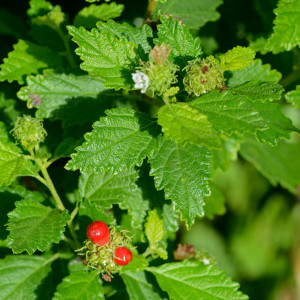
Honeybees are on the flowers from dawn till dusk.
And even though it’s not a larval host plant for any butterfly that I know of, it’s one of the best butterfly nectar plants around, particularly for the smaller butterflies like the Fiery Skipper and the smaller blues and hairstreaks. In my yard, the following species have been seen on it (hit the links to recent photos for some species; the other species listed are ones for which I’m confident that I had photos before the hard-drive crash of Thanksgiving 2014):
- Atala Blue (Eumaeus atala)
- Mallow Scrub-Hairstreak (Strymon istapa)
- Martial Scrub-Hairstreak (S. martialis)
- Cassius Blue (Leptotes cassius)
- Ceraunus Blue (Hemiargus ceraunus)
- Horace’s Duskywing (Erynnis horatius)
- Fiery Skipper (Hylephila philaeus)
- Monk Skipper (Asbolis capucinus)
- Gulf Fritillary (Agraulis vanillae)
- Zebra Heliconian (Heliconius charithonia)
- Monarch (Danaus plexippus)
- Queen (Danaus gallipus)
- Great Southern White (Ascia monuste)
In addition to the ones listed above, I’m fairly certain that several other butterflies who frequent the yard also enjoy it, to wit:
- Little Yellow (Pyrisitia lisa)
- Barred Yellow (Eurema daira)
- Dainty Sulphur (Nathalis iole)
- Cloudless Sulphur (Phoebis sennae)
Heck, even dragonflies love it:
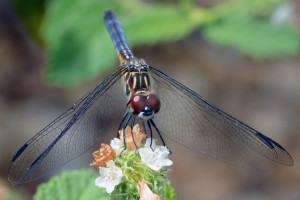
One of the reasons it’s such a good butterfly (and bird) plant is that the leaves and branches are stiff enough to support the weight of larger butterflies, but its flower clusters (inflorescences, to be technical) are shallow enough to allow short-tongued species to reach in:
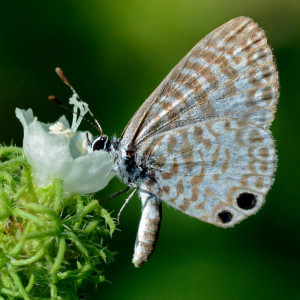
In fact, the flowers are so small and so inviting that they also attract the tiny halictid bees in the genus Lasioglossum chalcid wasps in the family Chalcidae, which seem to enjoy crawling around inside small flowers like Richardia, Lantana, and Cordia. Of course, when butterfly meets wasp, there’s sometimes a bit of a standoff.
And that’s what I found just the other day in the photo sequence below. In this first shot, the butterfly (a Cassius Blue) has just landed on the flower head and hasn’t yet probed it. The wasp appears to be playing a game of hide and seek, or perhaps peekaboo:
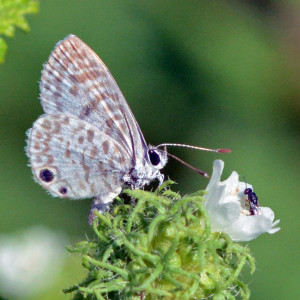

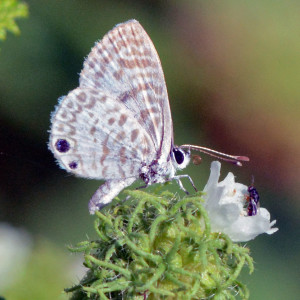
The first shot was taken about two seconds before the second and third ones, which were taken at “the same time” according to my camera’s info. If you look closely at the sequence of photos, you can see the butterfly backing away between the second and third shot after almost getting a proboscis full of wasp! I didn’t get close enough to verify through the lens, but I’m pretty sure the wasp has a self-satisfied smirk on its face.
And, in case you were wondering about the Cole Porter reference that started this post, here’s a picture of a pair of Cassius Blues enjoying the convenience of the butterfly sage plant in one of the most fundamental of ways:
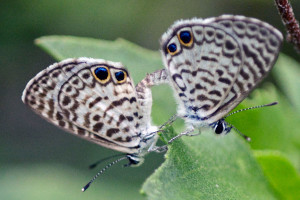
References
Austin, D. 2006. Florida Ethnobotany. Boca Raton, FL: Taylor & Francis.
Osorio, R. 2001. A Gardener’s Guide to Florida’s Native Plants. Gainesville: University Press of Florida.
